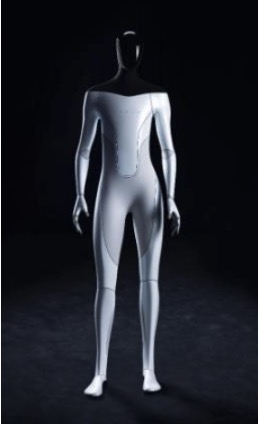So This Is Tesla’s Secret Weapon?
This week, Elon Musk announced that Tesla was building an android to complete repetitive and dangerous work tasks. Musk did not say how much it would cost, but the robot quickly fueled reminders of the film “Blade Runner”at best or nightmares at worst, depending on how you handled this image.

It’s another engineering marvel that Tesla has added to its arsenal. In recent years, Musk — best known for his company’s electric automobiles — has unveiled a tunnel construction company, cybertrucks, advancements in solar energy, and, of course, flamethrowers.
But there’s another massive project that has investors quite optimistic about the company’s future: battery technology.
Today, I want to highlight a few advancements in its battery storage business and explain why Tesla is quickly maturing into more than just a car company.
Tesla Versus Volkswagen
One of the great puzzles for Tesla bears in recent years has centered around the automotive business.
Tesla has been the world’s largest producer of electric vehicles (EVs) for years. However, the German automotive powerhouse Volkswagen is expected to surpass Tesla in EV production in the next few years. According to a Volkswagen executive, this move by the German firm could come as soon as 2023.
So, how does Tesla trade at a P/E ratio above 369, while Volkswagen’s is just 7.77?
How does Volkswagen trade at a price-to-tangible book value under 1, while Tesla’s price-to-tangible book value is 28.58?
Seriously, Volkswagen is worth less than the sum of its parts, but Tesla is worth more than 28 times its tangible assets’ value?
This suggests that either investors have made an egregious error in judgment, or they anticipate an incredible wave of growth and expansion by Tesla. Volkswagen is a great company, but it does remain a one-trick pony in the automotive sector.
Why are Tesla investors willing to pay more than $700 per share?
It’s not the automobiles, it’s…
Tesla’s Grid Power
When Musk unveiled his android last week, he argued that it would profoundly impact the economy.
Most of Tesla’s innovations feel fantastical. But with enough brainpower and advancements in technology, the company continues to bring forward staggering innovation.
The company has been well ahead of almost everyone on climate technology. Right now, venture capital companies are pouring more and more money into technology to reduce carbon emissions, mitigate climate events, and alter the way that energy is produced and stored.
Over the first six months of 2021, venture capital companies invested $14.2 billion in climate technologies. According to PitchBook, that figure is on pace to shatter the annual record set in 2018 of $17.9 billion in climate tech investment.
One of the hottest investment avenues is in the energy storage space. The capacity for new energy storage systems is expected to be five times larger than what we witnessed in 2020. But it’s clear to me that all of this early-stage money is chasing Tesla.
Tesla owns a subsidiary called Gambit Energy Storage, and it has created a 100-megawatt energy storage facility that could plug directly into the Texas state energy infrastructure. The result would be enough stored energy to power 20,000 homes on a hot day if the rest of the power grid buckles.
Tesla would store energy for the grid companies and then sell the electricity when prices get high or emergencies impact regular transmission.
This couldn’t be a more timely pursuit. In the wake of the massive cold snap that took down the Texas energy grid earlier this year, and the recent storms that battered the Northeast, backup power generation will be critical in the future. And it’s not just because of potential weather events. It’s also needed to store energy produced by non-carbon-based energy systems.
Before the Texas project launched, Tesla created a battery project beside a wind farm in Southern Australia. When launched, the 100-megawatt project was the largest battery product in the world and could collect and store energy produced from nearby windmills.
This project came a year after the South Australia region experienced a near-complete blackout due to a massive weather event that produced two tornadoes and nearly 80,000 lightning strikes. Tesla’s goal was to reestablish power in the region in less than 100 days by using its Powerpack lithium-ion batteries.
It completed the project in about 60 days.
The Future of Energy
Tesla’s energy division continues to create new battery systems across the United States. For example, its 20-megawatt battery system supports grid operations in Southern California, a region that faces a reckoning for hydroelectric power due to dwindling water supplies. It also has created a 182.5-megawatt system in the San Francisco Bay region to assist the Pacific Gas and Electric Company (PG&E), which has faced incredible challenges since the wildfires ravaged the area a few years ago.
According to research firm Piper Sandler, Tesla’s energy business represents 6% of its revenue today. However, it projects that the energy division may account for up to 30% of revenue by 2030.
Tesla is one of the most-watched stocks on Wall Street. At TradeSmith Finance, we’re always watching Tesla stock. It’s very volatile.
Right now, TradeSmith Finance shows that Tesla is a Buy in the Green Zone. However, investors should be cautious given that the stock is in a side-trend and has a VQ of 52.17%, which indicates sky-high risk.
Tesla offers immense upside thanks to its innovation and engineering prowess. If you’re going to buy into the stock, be sure to follow our signals to protect your profits and your principal.
I’ll be back tomorrow to talk more about other innovative companies.